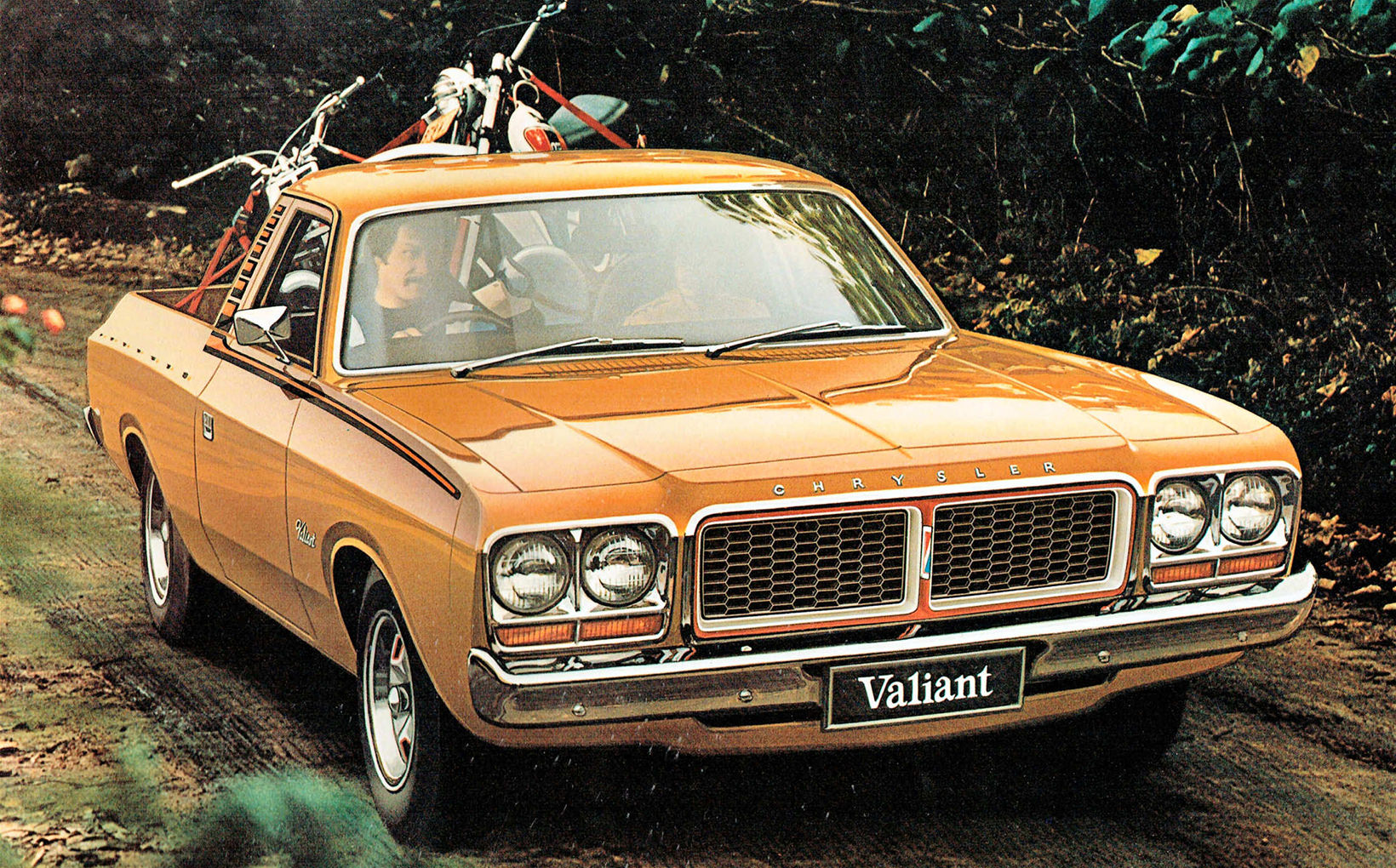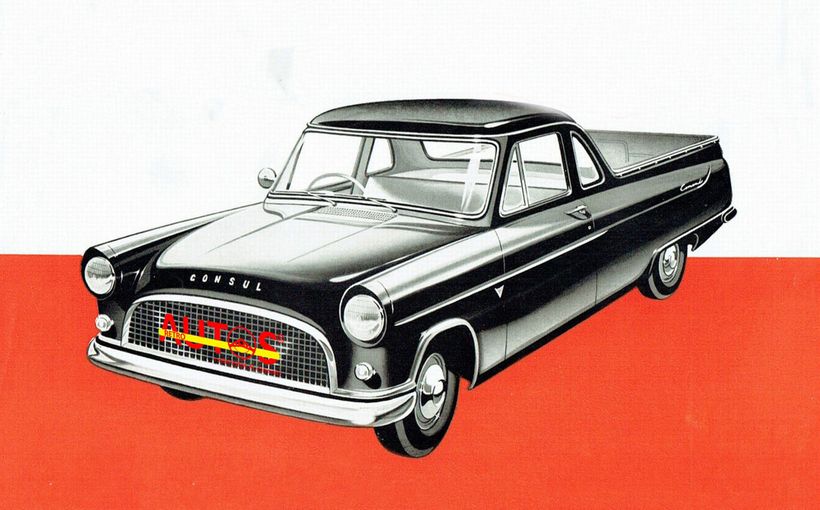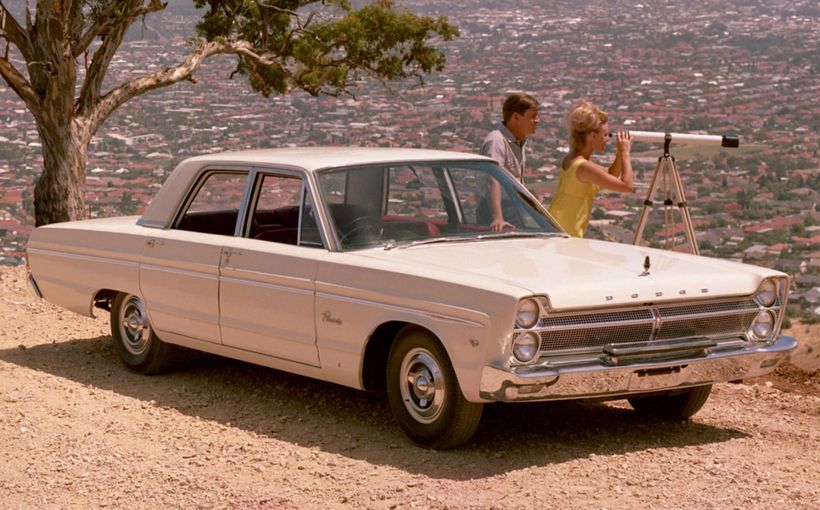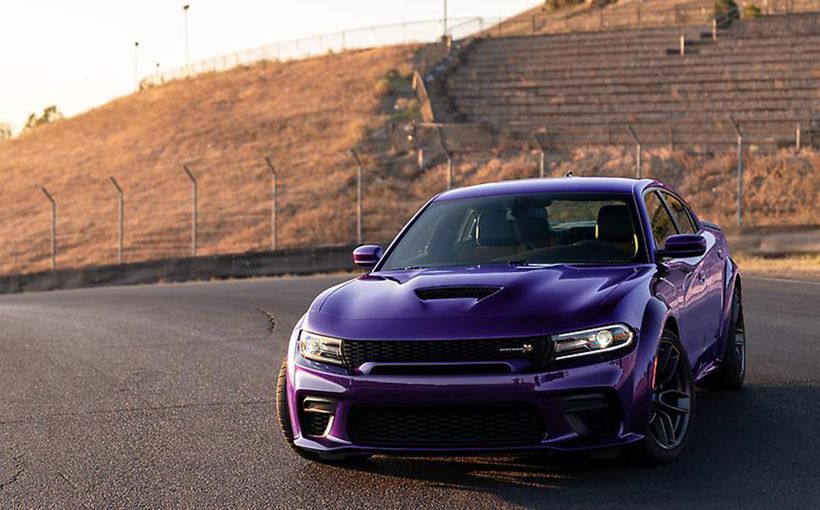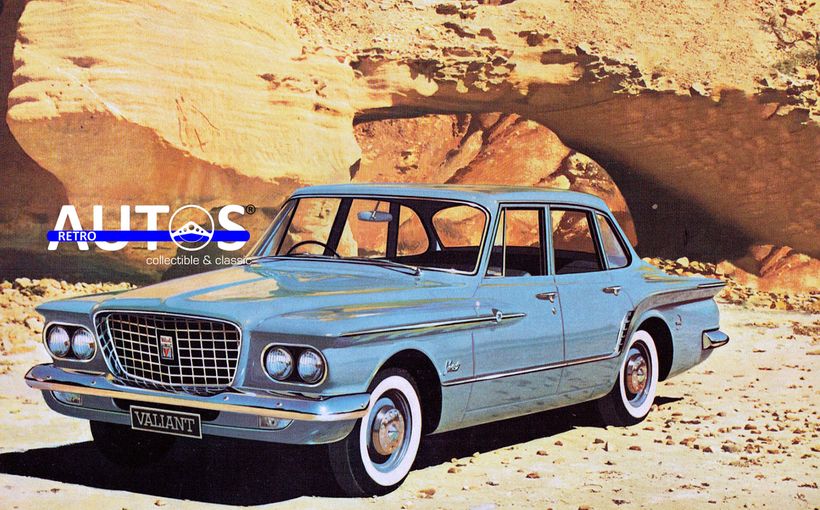Valiant/Dodge Utes and Vans: Chrysler's twin-badged Aussie workhorses

AP6 to VC (1965-1967)
Chrysler Australia launched its first Valiant utility in April 1965, a month after the release of the AP6 sedan from which it was derived. Like its Chrysler Royal-based predecessor, the first Valiant ute was called Wayfarer, which was a curious name given that it describes one who prefers to travel by foot!
It was identical to the AP6 sedan ahead of the B-pillar and shared its 106-inch (2692mm) wheelbase. The ute’s unique B-pillar was much thicker than the sedan’s but featured fine detailing comprising a decorative angle rain gutter, embossed Valiant logo and prominent Wayfarer badge across the base.
The rear window glass was also slightly recessed which added to the quality look and allowed enough interior space for a small parcel shelf.

Image: Stellantis
Like the rival Falcon ute, the spare wheel was stored in a compartment underneath the rear of an expansive load floor, which according to Chrysler was class-leading in terms of length and the width between its wheel housings.
The walls and tailgate had inner and outer skins for greater strength and outer-panel protection from scrapes and dents. The hardboard central load floor was protected by skid strips and a tonneau cover was standard.
The ute’s 1243kg kerb weight was about 30kg heavier than the sedan, with which it shared a powerful and economical 225cid (3.7 litre) inline six, also known as the ‘Slant Six’ due to its space-saving 30 degrees incline. This engine’s 145bhp (108kW) and 215ft/lbs (291Nm) was far superior to contemporary Ford and Holden rivals and available with a choice of three-speed manual (non-synchro first) or Torqueflite three-speed automatic, both with column-shift.

Image: Stellantis
"The finest automatic in the industry," boasted Chrysler about its widely praised Torqueflite transmission. "Smooth, silent, lightning fast changes coupled with the reserve power and sustained high engine torque of Valiant's 225 engine give automatic driving, at its easiest, safest, best."
The ute also shared the sedan’s front torsion-bar suspension, leaf-spring live rear axle and four-wheel drum brakes. However, given the Wayfarer’s load-lugging role, it was beefed up with heavy-duty shocks, uprated rear suspension with six-leaf spring packs (compared to the sedan’s four and wagon’s five leaves) and tougher six-ply 6.50 x 14 tyres.
The half-tonne payload rating was competitive with Falcon and Holden ute rivals and would steadily increase to more than three quarters of a tonne in future models.

Image: Stellantis
VC Series
The VC Valiant sedan launched in March 1966 brought distinctive new front and rear styling, with more squared-off lines and vertical tail lights. However, to minimise production costs, the new Wayfarer ute had a hybrid body style that combined the VC’s new looks ahead of the windscreen with the previous AP6 styling behind it.
This was not unusual at the time, as numerous ute and panel van models produced by Holden and Ford rivals also combined the latest fronts with previous model rears.
Even so, this was not an issue for typically pragmatic commercial vehicle buyers, who prioritised purchase price, load-carrying ability, low running costs and reliability over the latest styling trends.

Image: Stellantis
The VC Wayfarer’s mechanical specification was almost unchanged from the AP6, with the three-speed manual gearbox now full-synchromesh. Like its predecessor, the VC was also light on creature comforts, as you’d expect in utes of that era.
“Standard equipment includes door armrests, exterior rear-view mirror, courtesy switches on both doors, parallel action two-speed electric windscreen wipers, coloured floor mats, full-width instrument panel crashpad” boasted the sales brochure.
Even so, Chrysler Australia identified demand for an even more basic and lower-priced version of the VC Wayfarer, designed to appeal to fleet buyers, tradies and farmers. It also had a 136kg higher payload rating than the VC Wayfarer (680kg v 544kg) thanks to larger and stronger 7.00 x 14 six-ply tyres.

Image: Stellantis
Having retained commercial rights to the famous Dodge brand name, this strictly work-focused variant was called the 106 Series. It was identified by unique Dodge body badges and grey-painted grille, bumpers, hubcaps, door handles and mirror.
It's interesting that Chrysler chose to follow this path, given that Holden briefly tried a similar strategy of using paint rather than chrome on the brightwork of its FC commercials in the 1950s, as a point of difference from the passenger car range. GM-H soon abandoned the idea though, to avoid having to produce chromed and painted versions of the same parts along with different part numbers etc.
“Take it anywhere, treat it rough” claimed the Dodge sales blurb and no doubt most owners would have obliged, given the hard-working role it was designed to play. This bare-boned workhorse proved popular enough to continue in future generations of Valiant utes, with its grey-painted body hardware a signature feature.

Image: Stellantis
VE to VG (1967-1971)
The all-new VE Valiant range was launched in October 1967, with distinctive new styling, a stretch in wheelbase from 106 to 108 inches (2743mm) and for the first time a choice of two engine specifications.
The new ute had a much stronger full-steel load floor than previous designs, which had relied on hardboard centres that were marginal in strength and damage resistance. This development and longer wheelbase contributed to the VE’s kerb weight increase of almost 70kg.
There was also a new two-stage tailgate, which could be positioned horizontally for a useful increase in load length or swing down to a vertical position to make the load floor easier to access, particularly from loading docks.

Image: Stellantis
As a result, the spare wheel and jack were relocated from the rear of the vehicle to a new compartment behind the cabin. This made good use of the large cavity under the load floor, accessed by tipping forward the bench seat’s backrest. It also created extra storage space for tools or valuables hidden from prying eyes.
Another first was a choice of three utes comprising base Valiant, premium Valiant Wayfarer and ‘heavy-duty’ Dodge. According to Chrysler, the upmarket Wayfarer “has touches of luxury on the doors and instrument panel, plus a cigarette lighter and glove-soft expanded vinyl seating to give that custom tailored look” in justifying its premium price.
All utes now shared the same 13cwt (660kg) payload rating. So, even though the Dodge was not more heavy-duty than the Valiant in terms of load-carrying, it was still marketed that way due to its austere work-focused specification: “The interior comes in long-wearing, heavy-duty grey vinyl, shrugs off hard wear…it’s rugged, powerful, built tough to take 13cwt loads” claimed Chrysler.

Image: Stellantis
Torsion bar front suspension, leaf-spring live rear axle and drum brakes were largely carried over from the VC but tyres were larger 6.95 x 14s with the same robust six-ply rating.
The venerable single-barrel 145bhp version came standard but, for the first time, ute buyers could option a more powerful version with two-barrel carburettor and higher performance camshaft producing a stomping 160bhp (119kW) and 220ft/lbs (298Nm). These outputs were far superior to contemporary Ford and Holden ute rivals. The even more powerful 273cid/4.5 litre V8 (145kW/359Nm) was also available for Wayfarer buyers, even though this option was not shown in sales brochures.
Three-on-the-tree manual was still standard issue, with Chrysler’s smooth Torqueflite three-speed column-shift automatic option available only in Valiant-badged utes and standard with the V8.

Image: Stellantis
VF Series
The VF Valiant launched in March 1969 was a facelift of the VE with few technical changes, although new models would be added to the range as the year progressed. The ute's V8 option was now the larger 318cid/5.2 litre 'Fireball' V8 with 230bhp (172kW) and 340ft/lbs (461Nm) available only with automatic. However, like the VE ute, a V8 option was not shown in VF brochures.
Chrysler continued to offer three utes comprising Valiant, Valiant Wayfarer and Dodge variants. They adopted the latest frontal styling, with new grille design and dual indicator lights neatly integrated with the tops of the front guards.
The VF utes also offered a new SureGrip limited-slip diff option, for increased traction in sand and mud often encountered on worksites and rural properties. The standard ratio was 3.23:1 but the SureGrip unit also offered shorter 3.50:1 and taller 2.92:1 options.

Image: Stellantis
VG Series
Launched in March 1970, the VG Valiant was the second and final facelift of the VE generation, highlighted by a new grille with rectangular headlights (except for the dual-headlight VIP prestige sedan). There was also a new instrument panel and other revisions.
The biggest VG news, though, was under the bonnet with introduction of the Australian-made ‘Hemi’ inline six. Based on a Chrysler US design originally intended for commercial vehicles, its hemispherical combustion chamber claim tested the credibility of Chrysler’s marketing department.
Even so, it was an excellent engine and more than a match for its Ford and Holden rivals, with a rugged seven-bearing crankshaft, outstanding V8-style torque across a broad rpm range and good fuel economy.

Image: Stellantis
The Hemi six was available in two cubic displacements in utes, starting with a standard single-barrel 215cid (3.5 litre) version with 104kW/271Nm.
The optional 245cid (4.0 litre) with single-barrel carb produced 123kW/319Nm while the premium two-barrel version packed 138kW/325Nm; the latter matching the power and almost the torque of Holden’s new 253cid (4.2 litre) V8.
Chrysler rationalised its ute line-up by dropping the base Valiant, offering buyers a clear choice between the work-focused Dodge and upmarket Wayfarer.

Image: Stellantis
The Dodge came standard with the venerable Slant Six (until stocks ran out) and three-on-the-tree manual, but buyers could option either the new 215 Hemi or 245 Hemi (123kW version only).
The Wayfarer came standard with the 123kW 245 Hemi and three-speed manual, but buyers could option the premium two-barrel 138kW 245 or 'Fireball' 318 V8 both with Torqueflite auto. The V8 option, like the VE and VF models, was not shown in VG sales brochures.
Tonneau cover was standard for Wayfarer and optional for Dodge, with other options for both including 11-inch front disc brakes, 3.23:1 SureGrip LSD and a largest-ever 13.5cwt (686kg) payload rating thanks to its larger six-ply 7.35 x 14 tyres.

Image: Stellantis
VH to CL (1971-1978)
In July 1971 the new-look VH Valiant was launched. With overbearing influence from the company’s US design chiefs, the new range had high hip lines with small side glass, bulbous flanks and long rear overhangs on a wider but still relatively narrow track; the latter evidence of yet another low-cost revision of a chassis platform that could be traced to the original 1962 R-series Valiant.
The new Valiants were perceived as ‘yank tanks’ by most Aussies and running a tape measure over the VH ute explained why. The VH was 76mm longer in wheelbase (now 111 inches), more than 50mm longer overall and 115mm wider. And with its hefty 1370kg kerb weight, more than 80kg heavier.
On the plus side, there was a definitive 265cid/4.3 litre version of the Hemi six and Chrysler claimed an unprecedented and class-leading 15cwt (762kg) payload rating or more than three quarters of a tonne.
Load volume was also without peer at more than 2.8 cubic metres and the 60mm wider rear track allowed a similar increase in load width between the wheel housings. The new interior design featured revised instrumentation and a floor-mounted handbrake.

Image: Stellantis
Chrysler returned to a three-model ute range comprising base model Dodge, mid-range Valiant and top-shelf Ranger; the latter sharing its name with the Ranger VH sedan and replacing the long-running Wayfarer nameplate.
Like its chrome-free ancestors the VH Dodge ute was austere and low-priced in appealing to fleet buyers - there wasn’t even a heater-demister. Its 215 Hemi six was tuned to run on standard petrol to minimise running costs, matched with a three-on-the-tree manual and drum brakes.
The return of the mid-grade Valiant brought increased standard equipment including a heater-demister, lockable glovebox, tonneau cover and special hubcaps, chrome ornamentation and badging. Front disc brakes were standard along with the 215 Hemi six and three-speed manual, but buyers could option the larger 245 Hemi and Torqueflite auto.


Image: Stellantis
Chrysler claimed the new top-grade Ranger was “for the first time a ute that’s really loaded with luxury!” with standard cigarette lighter, unique steering wheel applique, “rich vinyl upholstery” bench seat, tonneau cover and unique sill, grille and tail light mouldings. However, other exclusive luxury items like carpet, fold-down centre cushion armrest, bucket seats and rope-rails were extra-cost options.
The Ranger came standard with the 245 Hemi and three-speed manual but buyers could option the Torqueflite auto and potent new two-barrel 265 Hemi with 151kW/355Nm. Front disc brakes and anti-sway bar were also standard.
For buyers wanting more luxury and exclusivity than the Ranger, they could tick option code A77 for the ‘Town & Country’ dress-up package. This included a vinyl roof (unusual for utes), bucket seats, sports fuel cap, two-spoke sports steering wheel, special carpet, hubcaps and dress-rims plus unique body black-outs, stripes and badges.

Image: Stellantis
VJ Series
The VJ Valiant launched in April 1973 was the first facelift of the VH. However, given the dismal sales of the VH range apart from the award-winning Charger sporty coupe, combined with Chrysler Australia’s US parent also feeling the pinch, there were no development funds in the pipeline to fix the VH’s fundamental styling flaws.
Therefore, the VJ facelift was confined to new grille designs with round headlights, revised tail light detailing, instrumentation and other minor changes. Engines were also upgraded with electronic ignition.
The ute range was again reduced from three models to two, now comprising only Dodge and Valiant models. Chrysler described the latest Dodge as “a strictly practical workday ute, a true utility truck” largely unchanged from VH. Standard drivetrain was still the 215 Hemi six with three-on-the-tree, but Dodge buyers could now option front disc brakes and either the single-barrel 245 Hemi or two-barrel 265 Hemi sixes.
The Valiant version, which Chrysler claimed was “a ute that doubles beautifully as a car” gained extra creature comforts plus the exclusive options of Torqueflite automatic and for the first time Chrysler’s venerable ‘Fireball’ 318cid/5.2 litre V8 with 172kW/461Nm. The Town & Country dress-up option was also offered for a second and final time.

Image: Stellantis
VK Series
The VK Valiant was the second facelift of the VH. Launched in October 1975, upgrades were limited by Chrysler Australia’s increasing financial constraints.
However, base models did include a fresh vertical-slat grille design adopted from the VJ Charger, a new steering column stalk which controlled all wiper/washer/head light/indicator functions and a new brake-proportioning valve to prevent rear-wheel lock-up. The VKs were also backed by Chrysler’s new 12 months/unlimited km warranty.
The ute line-up went back to the future in offering only one model for the first time since the original AP6 Wayfarer. It was also the first time Chrysler did not offer a Valiant ute, as there was only a Dodge-badged version.

Image: Stellantis
More evidence of Chrysler’s cost-cutting was that the standard VK Dodge ute looked identical to the VJ model it replaced, grille and all. However, in addition to the new multi-function steering column stalk and brake-proportioning valve, it benefitted from the latest engine refinements including electronic ignition, automatic choke and a hot air intake for more efficient cold weather starts.
In line with industry conversion to metric measurement, cubic inch displacement (cid) was replaced by litres in identifying engines. So, the Dodge ute’s standard two-barrel 215 was now the Hemi 3.5 litre, the optional two-barrel 245 was the Hemi 4.0 litre and the largest two-barrel 265 was now the Hemi 4.3 litre. All were available with either standard three-speed manual or optional automatic, both with column-shift.
Chrysler also broke with the Dodge ute’s strictly workhorse tradition by offering buyers comfort and performance options previously denied including air conditioning, push-button radio, radio/stereo cassette player, tinted laminated windscreen, automatic transmission and a choice of three Hemi sixes.


Image: Stellantis
The new Sports Pack (option code A53) was another departure from Dodge orthodoxy, aimed at a booming youth market embracing dressed-up utes and particularly panel vans as lifestyle machines for weekend getaways. These were typified by rival Holden Sandman and Falcon Surferoo/Surfsider options.
The Sports Pack’s standard drivetrain was a 4.0 litre six and three-speed manual floor-shift plus three-spoke sports steering wheel, four-dial (with tacho) instrument panel and sporty grille from the Charger 770, bucket seats, deep-pile carpet, unique body stripes that “tell everyone else you’re no ordinary man”, tonneau cover, 6.0-inch sports wheels, a choice of 11 bold body colours and four new interior colours.
More options could be added to enhance the Sports Pack experience including air conditioning, premium 4.3 litre engine, SureGrip LSD, four-speed manual floor-shift, three-speed auto with centre console-shift, power steering and 7 x 14 mag wheels with steel-belted radials. Based on anecdotal evidence, the VK Dodge Sports Pack ute must be one of Australia’s rarest Mopars.

Image: Stellantis
CL Series
The CL Valiant was released in November 1976, featuring the third and final facelift of the venerable VH launched in 1971. Although there were increasing doubts about Chrysler Australia’s long-term viability, the Adelaide-based company showed it was not going down without a fight.
The CL facelift was more substantial than previous VJ and VK efforts, as it was the first time in three model changes that new sheetmetal was used in the design of the bonnet and nose-cone. There were also distinctive new rectangular grille and dual-headlight assemblies and the sedan’s boot-lid, rear quarters, rear bumper and taillights were also new.
At launch all CL engines incorporated changes to comply with new ADR 27A rules limiting exhaust emissions. By 1978 they were also equipped with Chrysler’s latest computer-controlled Electronic Lean Burn (ELB) spark control system, developed by the company’s US division in collaboration with NASA to minimise emissions and optimise fuel economy.

Image: Stellantis
In 1978 Chrysler also introduced its ‘Handling Package’ in response to Holden’s highly acclaimed Radial Tuned Suspension (Ford produced a similar offering). Like RTS, the Chrysler package sharpened the CL’s handling response through changes to suspension geometry, springs and anti-sway bars.
The CL was also the last Valiant ute produced by Chrysler Australia, as it was not offered in the final CM range that sustained Valiant production until the company’s demise in 1981. There was also no Dodge variant for the first time since the 1966 VC series.
The ute shared the sedan’s new front clip, with its dual headlights being another first for Valiant commercials. Standard engine was the Hemi 4.0 litre tuned for regular petrol, with optional Hemi 245 HC (High Compression tuned for premium petrol), Hemi 4.3 litre and 5.2 litre V8. All were available with three-speed manual or automatic with column-shift.
The Sports Pack option returned for the CL ute, offering all the features of the previous VK version including the latest Charger grille, which had a sportier look with separate honeycomb-patterned mesh inserts and a chrome outline.

Image: Stellantis
A surprising development was revealed in April 1977 with the launch of Australia’s first Valiant panel van. Many questioned why it had taken so long to develop this variant given the youth-driven boom in panel van ownership had started years before and already peaked. In other words, Chrysler arrived too late to this party.
The panel van had a raised roof like its Holden and Ford rivals to optimise load volume and, given that it was based on the CL ute, a new single-lift upper tailgate supported by gas struts.
Although there was generous load floor length, it was also criticised for reducing interior space as the seats had been moved forward to accommodate it. As a result, the only way to recline the backrests was to slide the seats further forward, which left taller drivers too close to the steering wheel and pedals.

Image: Stellantis
The panel van shared the ute’s engine and transmission options and could be ordered with or without side windows in the load area. Even so, in basic workhorse form with bench seat and hubcaps, it was far from appealing to the younger Aussies Chrysler was desperate to attract.
So, the Sports Pack option was also made available to panel van buyers. Chrysler evoked “The spirit of Charger” in promoting this package.
It also signalled a subtle shift in branding which saw it advertised as the Chrysler Sports Van while displaying Valiant plates. This package included full-length headlining and floor carpet plus a separate dome lamp in the load area.

Image: Stellantis
The best-known CL panel van was the Chrysler Drifter (option code A80) which was effectively the Sports Pack taken to the extremes of 1970s in-ya-face panel van fashion.
Standard drivetrain was the Hemi 4.3 litre six with four-speed manual floor-shift, but the Drifter’s most striking and memorable feature was the wild trio of side stripes which ran the full length of the vehicle and fanned out into much wider stripes towards the rear.
The Drifter package, which included matching paint black-outs, body decals and colour-coded sports wheels, was available in a choice of contrasting colour combinations comprising Alpine White, Orange, Lemon Twist and more. The eye-catching Drifter package proved contagious at Chrysler, as it was also made available on CL utes and even CL Chargers.




Image: Stellantis
Even so, despite Chrysler Australia’s best efforts, the CL utes and vans did not attract the sales volumes needed to ensure their continuation in the final CM Valiant series launched in November 1978. Sadly, their demise was the end of another colourful chapter in Australian car manufacturing.
Fact is, the homegrown Valiant/Dodge commercials built in South Australia from 1965 to 1978 never threatened the sales volumes of rival Holden and Falcon equivalents.
Even so, every ute or panel van built by Chrysler Australia at its Tonsley Park plant in Adelaide during that relatively brief 13-year period were integral in the nation’s rapid post-war social and economic development and are quite rightly prized by Aussie enthusiasts today.

